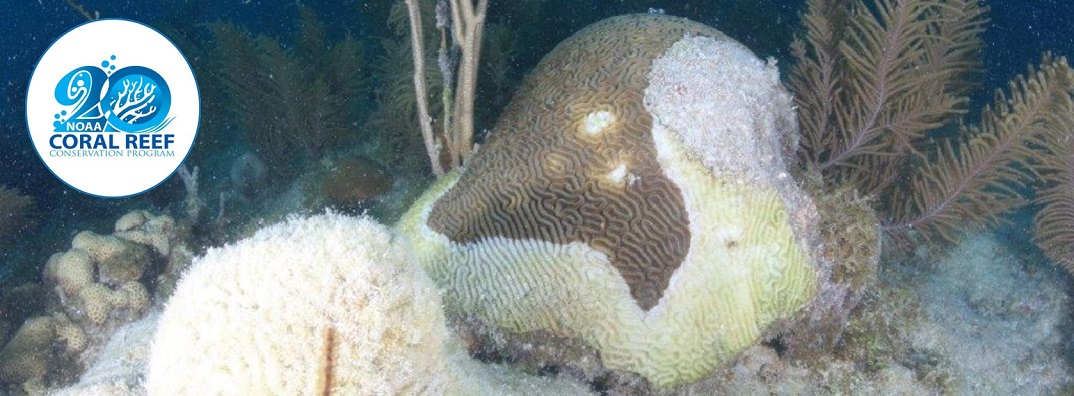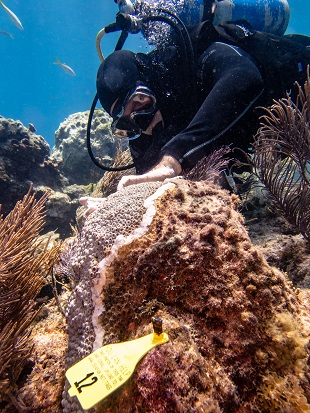- ABOUT US
- PROGRAM AREAS
- CONSERVATION APPROACH
- EDUCATION
- MULTIMEDIA
- Coral Heroes: The Coral Restoration Consortium
- Coral Heroes: FORCE BLUE
- Coral Heroes: Dr. Ruth Gates
- Coral Heroes: Reef Resilience Network
- Coral Heroes: The Micronesia Conservation Trust
- Coral Heroes: The National Marine Sanctuary Foundation
- Coral Heroes: The National Fish and Wildlife Foundation
- Coral Heroes: The International Coral Reef Initiative
- Coral Heroes: The Gulf and Caribbean Fisheries Institute
- Coral Heroes: The Puerto Rico Department of Environmental Protection
Coral Heroes: The Stony Coral Tissue Loss Disease Response Team
Throughout the Coral Reef Conservation Program’s 20th Anniversary, we are highlighting Coral Heroes — individuals and organizations that have worked with the program and are making a real difference in coral reef conservation.

Throughout the history of coral reef conservation, there have been many distinct events—from vessel groundings to bleaching and disease events—that required numerous different government agencies and organizations to come together quickly to preserve and restore coral reef ecosystems. The coral reef community is currently facing such an event.
The stony coral tissue loss disease response team is a large and collaborative endeavor focused on addressing the disease in Florida, where it was first observed in 2014. Unlike other known coral diseases, stony coral tissue loss disease affects many stony coral species, causes high death rates, and has lasted for multiple years. The cause of the disease is still unknown, adding to the difficulty in the response. Stony coral tissue loss disease is now affecting corals in 16 Caribbean countries and territories.
“This disease affects half of Florida’s reef-building coral species, including the ones that provide habitat for thousands of marine species and shoreline protection for millions of people. We’ve seen an incredible response here in Florida thanks to the willingness of the community and numerous organizations to come together and look at what’s causing this and what can be done to address it,” said Sarah Fangman, superintendent of Florida Keys National Marine Sanctuary.
The response team is led by NOAA, the National Park Service, the Florida Department of Environmental Protection, and the Florida Fish and Wildlife Commission, and includes over 30 other federal, state, and local agencies, academic institutions, nonprofit organizations, and other groups. NOAA specifically leads the teams focused on research and epidemiology, coral rescue, propagation, communications and outreach, regulations, and Caribbean coordination. Other teams are working on intervention, restoration, and data management.

“Over $20 million in funding has been invested by the state this year for dedicated resiliency efforts, including coral protection and restoration projects,” said Florida Florida Department of Environmental Protection Secretary Noah Valenstein. “With the support of cross-sector partnerships like this, Florida has taken critical steps to restore and protect this precious resource. Together, we are committed to developing innovative, multi-faceted solutions to ensure Florida’s Coral Reef remains protected for future generations.”
Many strides have been made, such as connecting with the diving community to help identify diseased corals and monitor treated corals, and sharing best practices throughout the Caribbean region. The team has also witnessed successful coral spawnings both in aquarium environments and in the water by restored corals.
“For decades, as leaders in animal care and welfare, the Association of Zoos and Aquariums’ accredited facilities have collaborated to inspire thoughtful environmental stewardship and drive significant conservation efforts for many species, including native species, like corals,” said Beth Firchau, Florida Reef Tract Rescue Project Coordinator for the Association of Zoos and Aquariums. “The AZA is proud to be a part of bringing hope to Florida’s Coral Reef. Currently, at the request of the coral rescue team, 18 accredited facilities in 12 states are providing homes for nearly 2000 Florida corals and building a strong foundation for future propagation and restoration efforts.”
Stony coral tissue loss disease has become an opportunity to learn more about coral biology and physiology, and about how to use that knowledge to improve coral reef conservation and restoration. The response team has and will continue to serve as a model for what the coral reef community can accomplish together.
Follow the celebration on our Facebook and Twitter pages and the National Ocean Service Instagram page all year using the hashtag #NOAACoral20th.
Related Stories and Products
About Us

The NOAA Coral Reef Conservation Program was established in 2000 by the Coral Reef Conservation Act. Headquartered in Silver Spring, Maryland, the program is part of NOAA's Office for Coastal Management.

The Coral Reef Information System (CoRIS) is the program's information portal that provides access to NOAA coral reef data and products.
Work With US
U.S. Coral Reef Task Force
Funding Opportunities
Employment
Fellowship Program
Contracting Assistance
Graphic Identifier
Featured Stories Archive

Access the archive of featured stories here...
Feedback
Thank you for visiting NOAA’s Coral Reef Conservation Program online. Please take our website satisfaction survey. We welcome your ideas, comments, and feedback. Questions? Email coralreef@noaa.gov.
Stay Connected
Contact Us
NOAA’s Coral Reef Conservation Program
SSMC4, 10th Floor
1305 East West Highway
Silver Spring, MD 20910
coralreef@noaa.gov
